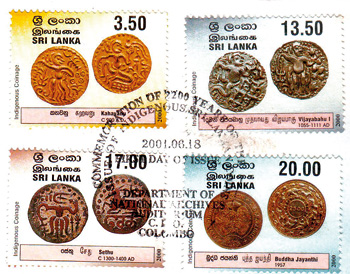Coins have been used
in Sri Lanka since
pre-Christian times.
The chronicles, Buddhist
literature and inscriptions refer to the earliest coins known as 'kahapana' – a silver coinage which had come from India. They were rectangular pieces of silver of an average weight of 56 grams, on which were impressed various punch marks on both sides.
These coins were probably issued by the trading guilds with the permission of the king. These had been in use from the pre-Christian times till around the
3rd century A.D.
Between the 3rd – 8th centuries, circular copper coins with 'svastika'
and elephant or other
symbols like the lion,
Goddess Lakshmi, a horse had been used.
The noteworthy gold coinage of the Sinhalese was the 'kahavanu' or the 'Lankeshvara' which had been in use in the 9th and 10th centuries. 'Kahavanu' seen in the
Rs. 3.50 stamp is the oldest Sri Lankan coin inscribed in Nagari, one of the oldest North Indian scripts. The coin seen on the stamp belongs to the weight category known as 'kalanda'.
(The term is still used in
measuring some native medicines).
There were at least four weights in the category – half (ada-kahavanu), quarter (de-aka),
one eighth (aka) and
one sixteenth (masaka). The obverse and the reverse of the coin depict a stylized human figure in standing and seated
positions.
Following the invasion by the Cholas, the capital shifted to Polonnaruwa. The Cholas ruled until Vijayabahu I ascended the throne in 1055 A.D. He is the first Sinhalese king whose name appears on coins. Referred to as the 'Ceylon type', the coins were the same as what was current in the late Anuradhapura era, referred to above.
The Chola king Rajaraja I had imitated these coins with the
substitution of the king's name in Nagari
characters in place of the legend 'Lankesvara'
or 'Lankavibhu'.
A coin issued by Vijayabahu I is seen in
the Rs. 13.50 stamp.
The coinage by this time had been debased and Vijayabahu's issues were of very poor gold and
silver washed with gold. The use of precious metals had ceased with the issue of coins during the reign
of Parakramabahu I. Silver was, however, used to wash coins of base metal. King Nissankamalla issued few coins, some of which were white metal. In later times, there were prolific issues of copper coins.
The Arya Chakravartis, rulers in Jaffna peninsula issued similar coins in a modified form. On the reverse of the coin (Rs. 17 stamp) shows a bull lying down with trappings and the legend 'setu' in Tamil characters. The seated bull is always surmounted by a crescent with a dot signifying the sun and moon and the auspicious Tamil legend 'setu' below. These coins attributed to the 13th and 14th
centuries at the earliest, were copper ones. The coin illustrated on the stamp was 3.87g in weight and 20mm in diameter.
A thin, circular gold or silver coin of an average diameter of ¼ inch and a weight of 5.8 grains, known as the 'panam', was the currency of the Gampola period.
While the local coins were in use, there had been numerous types of coins of foreign
countries that had found their way to Sri Lanka. This was due to trade activities and diplomatic missions. Dr. Senarat Paranavitana identifies several foreign currencies in circulation prior to the arrival of the European powers. There were the silver larins or fish-hook coins of Persia, the gold seraphins of Ormuz on the Persian Gulf, Pandya issues of Sundara Pandya, the 'varagam' of Vijayanagara, the
'pagodas' of the Gajapati kings of Orissa, and Chinese coins mostly of the Southern Sung
emperors.
The find of a large hoard of Chinese coins together with Sung
celadon bowls, at Yapahuva, has been
quoted as evidence of
the diplomatic and
commercial relations with China towards the close of the 13th century.
The commemorative issue of stamps
depicting indigenous
coinage released on
June 18, 2001 had four stamps. Three have already been discussed and the fourth was the first commemorative coin issued by Sri Lanka since independence in 1948.
It was to mark the Buddha Jayanthi year (1956) when a five rupee coin was issued
commemorating the 2500th anniversary of the passing away of the Buddha.
The Buddha Jayanthi coin was the first
Sri Lankan 'Crown' size issue – a 925 fine silver with a weight of 436.55g and 1.525 inches in
diameter.
The design had an adaptation of the Anuradhapura moonstone and a jasmine flower
surmounted by a lotus flower. It is significant that the jasmine flower and the lotus had been retained through our indigenous coinage in
various forms from the earliest 'swastika' coins. |


